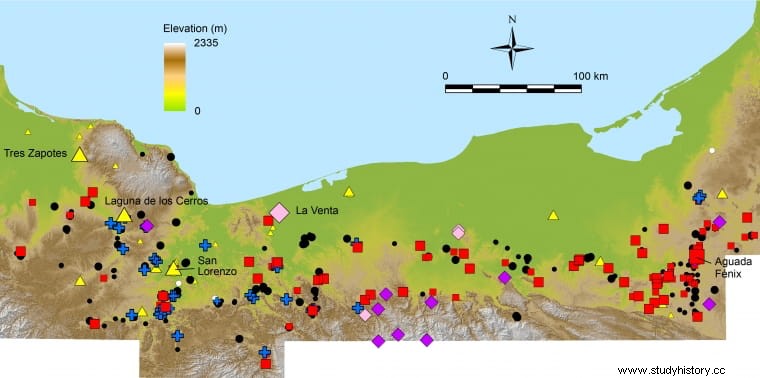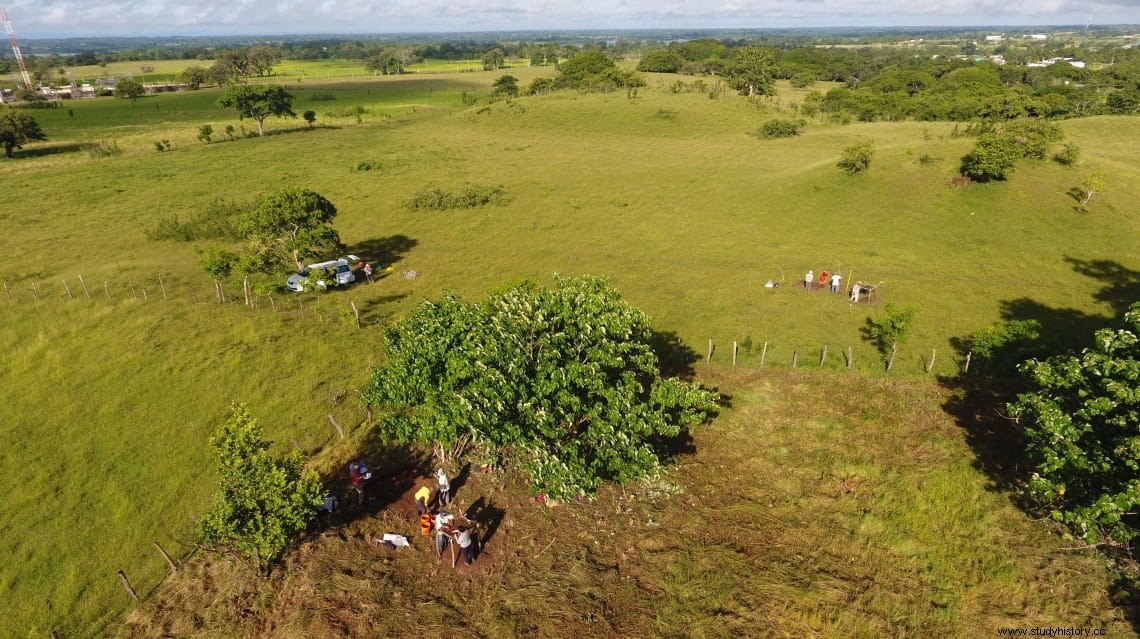A team of international researchers led by the University of Arizona reported last year that they had discovered the largest and oldest Mayan monument:Aguada Fénix. That same team has now discovered nearly 500 smaller ceremonial complexes that are similar in shape and features to Aguada Fénix. The find transforms previous understanding of the origins of Mesoamerican civilization and the relationship between the Olmecs and the Maya.
The team's findings are detailed in an article published in the journal Nature Human Behavior . UArizona anthropology professor Takeshi Inomata is the paper's first author. His UArizona co-authors include anthropology professor Daniela Triadan and director of the Accelerator Mass Spectrometry Laboratory Greg Hodgins.
Using data collected using an airborne laser mapping technique called lidar, the researchers identified 478 complexes in the Mexican states of Tabasco and Veracruz. The lidar penetrates the treetops and reflects the three-dimensional shapes of the archaeological elements hidden under the vegetation. The lidar data was collected by Mexico's National Institute of Statistics and Geography and covered an area of 32,800 square miles, which is roughly the same size as the island of Ireland.

Publicly available lidar data allows researchers to survey vast areas before following up with high-resolution lidar to study places of interest in greater detail. Until a few years ago it was unthinkable to study such a large area Inomata said. Publicly available lidar is transforming archaeology .
There is a long debate as to whether the Olmec civilization led to the development of the Mayan civilization or whether the Mayan civilization developed independently.
The newly discovered deposits are found in a wide area that encompasses the Olmec region and the western Maya lowlands. The complexes were probably built between 1100 B.C. and 400 B.C. and they were built by various groups almost a millennium before the height of the Mayan civilization, between 250 and 950 A.D.
The researchers found that the complexes share similar characteristics with the oldest center in the Olmec area, San Lorenzo, which reached its peak between 1400 and 1100 BC. Aguada Fénix, in the Mayan area, and other related sites began to take the form of San Lorenzo and formalize it around 1100 BC
At San Lorenzo, the team also found a previously unrecognized rectangular space. Reservoirs are large horizontally but not vertically Inomata said. People will be walking over one and won't notice its rectangular space, but we can see it with lidar just fine .
The researchers' work suggests that San Lorenzo served as a template for later constructions, including Aguada Fénix. People always thought that San Lorenzo was very unique and different from what came after in terms of site layout Inomata said. But now we show that San Lorenzo is very similar to Aguada Fénix:it has a rectangular plaza flanked by edge platforms. These features are very clear on lidar and are also found at Aguada Fénix, which was built a little later. This tells us that San Lorenzo is very important for the beginning of some of these ideas that were later used by the Mayans .

The sites discovered by Inomata and his collaborators were likely used as ritual meeting places, according to the document. They include large open central spaces where many people could gather and participate in rituals.
The researchers also analyzed the orientation of each site and found that they appear to be aligned with sunrise on a given date, when possible. There are many exceptions; for example, not all sites have enough space to place the rectangular shape in the desired direction, but when they can, they seem to have chosen certain dates said Inomata.
Although it is not clear why these particular dates were chosen, one possibility is that they are linked to the zenith passage day, which is when the sun passes directly overhead. This occurs on May 10 in the region where the deposits were found. This day marks the beginning of the rainy season and the sowing of corn. Some groups chose to orient their deposits toward the directions of sunrise on days 40, 60, 80, or 100 before the zenith passing day. This is significant because later Mesoamerican calendars are based on the number 20.
San Lorenzo, Aguada Fénix, and a few other sites have 20 edge platforms along the eastern and western sides of the rectangular plaza. Border platforms are mounds placed along the edges of large rectangular plazas. They define the shape of the squares, and each of them is usually no more than a meter high. This means that they represented cosmological ideas through these ceremonial spaces Inomata said. In this space, people gathered according to this ceremonial calendar .
Inomata stressed that this is only the beginning of the team's work. There are still many unanswered questions , He said. The researchers wonder what the social organization of the people who built the complexes was like. It is possible that San Lorenzo had rulers, as the sculptures suggest.
But Aguada Fénix doesn't have those things Inomata said. We think that people were still moving around in some way, because they had just started using pottery and lived in ephemeral structures on the ground level. People were transitioning to more settled ways of life, and many of those areas probably didn't have much hierarchical organization. But even so, they could create these types of centers very well organized .
Inomata's team and others continue to search for more evidence to explain these differences in social organization. Continuing to dig the sites to find these answers will take much longer , Inomata said, and will implicate many other scholars .
